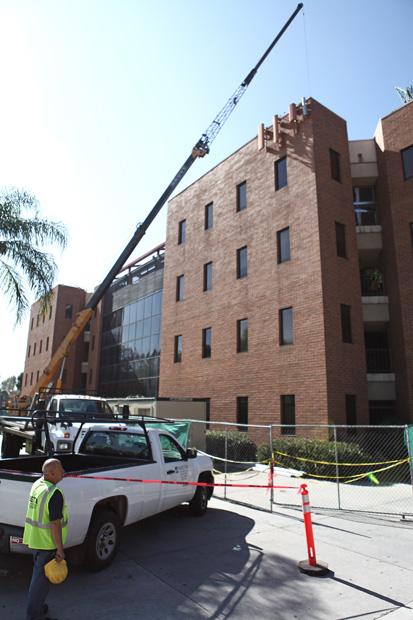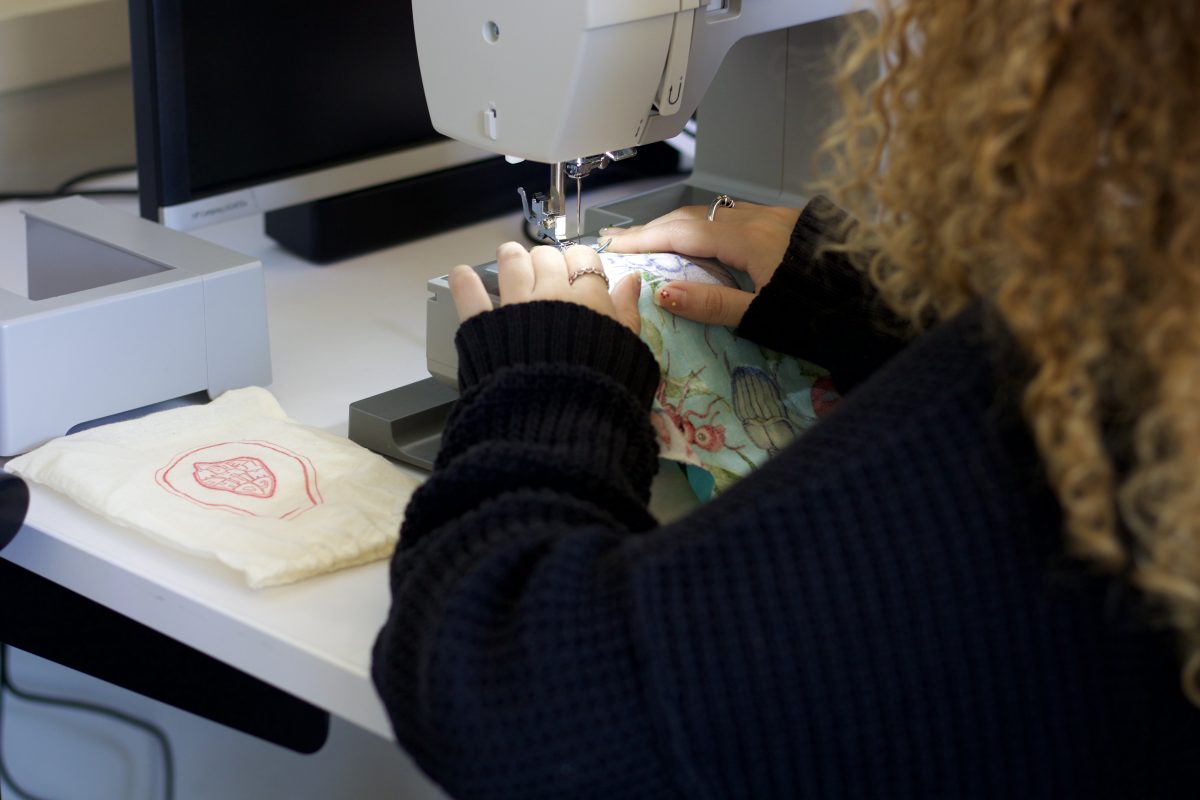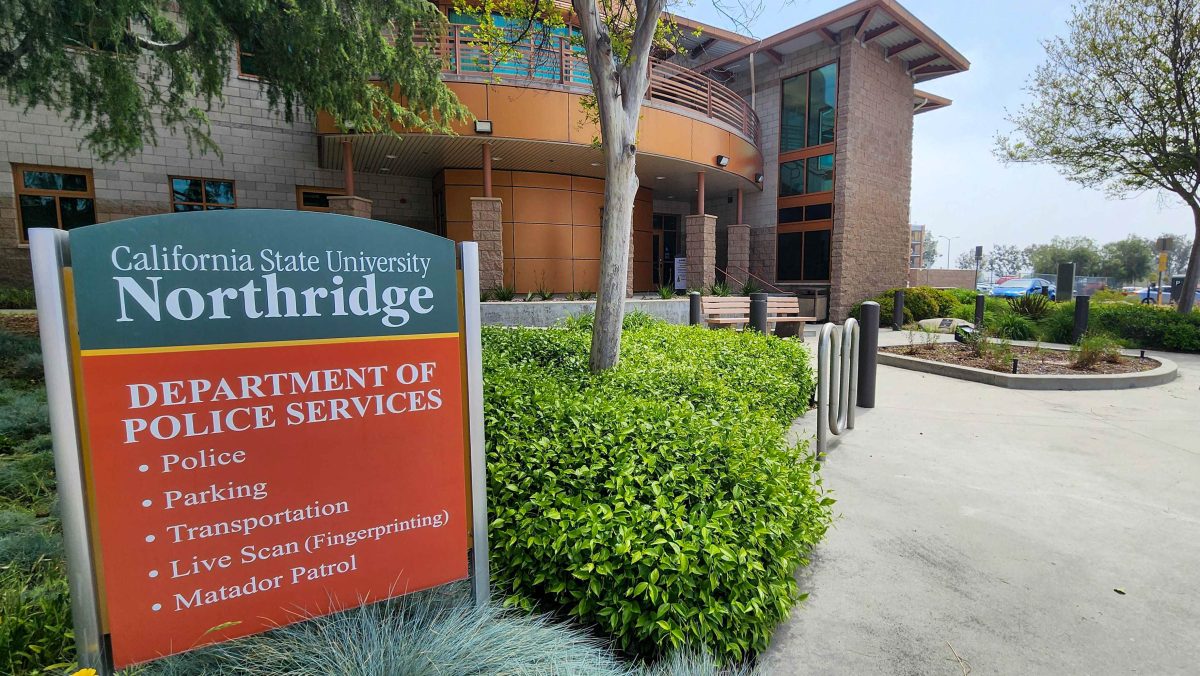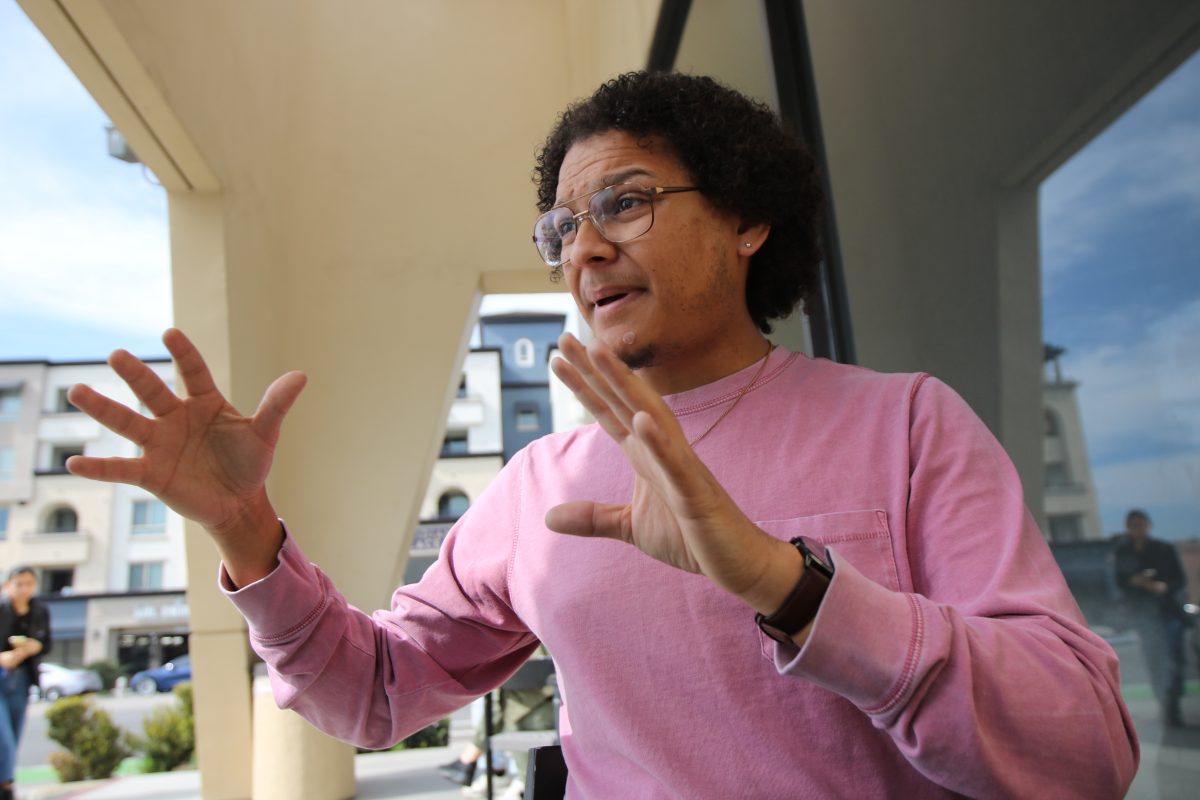
Replacement of Santa Susana Hall’s roof is expected to finish this month, the only task remaining of the project that began in August is a structural cover for the building’s maintenance well. The deferred maintenance project is meant to address persistent water leakage within the building at a cost of about $550,000.
Leaks, however, are just one of a variety of Santa Susana’s problems, including a bipolar heating and cooling system, which current faculty says affects both physical and working climates and have persisted since the building was erected.
Herman Debose, chair of sociology, said the leaks were common when he first got into the building in 1997. His office is one of the first affected by the sometimes-severe leaks, the remnants of which have stained the interior walls of the department office.
“Herman’s office, in particular, is sitting right under the mechanical well and all the equipment is packed right over the top of Herman,” said Ken Rosenthal, manager of construction services for CSUN’s Facilities and Planning department.
Rosenthal explained that the building’s poor design made it physically impossible to access certain areas to address leaks until the current project removed structural barriers.
Rosenthal’s business card is one in a collection Debose keeps around because of the building’s many issues. Debose said Santa Susana’s design flaws do not just affect the comfort of faculty, but also their ability to meet with students.
“If you’re a student and came to see a faculty member, and you had to sit out here – if it’s cold you’re sitting in the cold cause we don’t have any place else to put you unless you sit by the elevators,” Debose said. “But then if you sit by the elevators when the faculty member is free, if their office is way over there, how do you know?
“It’s not a good building, it’s poorly designed, and I don’t think that it has served the best interests of the students but – I mean – I don’t have any power to move faculty anywhere so we’re stuck,” he added.
Last year CSUN replaced the heating, ventilation, and air-conditioning system (HVAC) on the fourth floor of Santa Susana with a more energy-efficient system, a total cost of about $627,800. Rosenthal estimates the savings for the one floor should be significant considering that the HVAC system for the remaining floors runs constantly, even when unoccupied.
“The air and the heating has been, actually, ridiculous,” said Rick Talbott, chair of religious studies.
Talbott remembers an instance during a cold snap when he walked into his office to find that the air conditioning had been on all night.
The fourth floor’s offices, which now have occupancy sensors, were replaced as a precursor for the current project because the old HVAC handling units for the floor used to sit on top of the roof. Rosenthal said the school looked into replacing the HVAC system for the rest of the building, but lacked the funding to follow through.
“We have many buildings on campus that have priorities, and you have to deal with the resources at hand… in the order at which they occur,” said Rosenthal. “Santa Susana in particular has a lot of engineering and construction problems that are difficult to overcome.”
Rosenthal says that because the current work has essentially cleared the roof of impeding structures, previously inaccessible areas like the maintenance well have uncovered HVAC leaks in the ductwork, which have promptly been fixed.
Then as now
From above, the 27,000-square-foot building resembles a figure eight with two towers each enclosing an atrium, and connected by a core area that currently houses five departments on four floors. Because many of the building’s 100 offices face a courtyard exposed to the elements, its occupants often have to keep their doors closed.
The figure eight could also be a metaphor for the building’s perceived life cycle: infinite problems.
Even after approval in 1975, a weak economy in the early 1980s meant Gov. Jerry Brown, at the end of his first run as governor, would put a halt to non-essential spending.
Twenty-eight years later, Brown is again governor of a state facing huge fiscal shortfalls, construction is once again put on hold, and Santa Susana still faces the same problems it had since its initial completion.
“We’d all like to replace Santa Susana Hall and it’s a frustration that we can’t at the moment,” said Harry Hellenbrand, provost and vice president of Academic Affairs.
The original design called for a 38,000-square-foot building with 140 offices, but was reduced by 40 offices due to a 40 percent inflation increase, short of the 139 offices the building was meant to replace. In addition, cheaper materials, namely clay brick, replaced the more expensive cement material that was in the building’s original design, said Michael Nakamoto, former assistant director of facilities planning in a January 1983 edition of the Sundial.
By December 1984 Charles Manley, former director of facilities, said to the Sundial that construction for the building once again exceeded the allotted budget by $600,000. The overspending forced designers to omit features including operable windows and a sprinkler system—a fact that meant the building did not initially meet fire regulations. It was then retrofitted with standpipes on the outsides of the structure.
The faculty offices officially opened October 1984 and it only took a change of seasons to reveal the many problems that afflicted it. Rain soon revealed that the stairwells were canted the wrong way, creating puddles of water at entryways, which then required piping and drains.
The cost-saving clay brick essentially made the building a large kiln with windows that no longer opened, quick to gain heat in the San Fernando Valley summer, but unable to retain it during the winter. Additionally, the HVAC in the offices had an insufficient amount of dampers in the air ducts. As a result, airflow in the building is poor and has persisted to this day.
Like the present, wet conditions led previous faculty to report dampness in the interior of certain offices as well as leaks in others.
“The northwest corner office has fungus that grows on the wall each winter,” said former faculty member Audrey Vanderwier in a 1988 edition of the Sundial.
By September 1987, the school was reaching a settlement with architect Howard R. Lane on the many defects of the building, however, renovations to remedy the issues did not begin until the summer of 1988 and ultimately would not fix the problems. Lane would die of a heart attack several months later, and his firm would go on to sue the company in charge of implementing the summer renovations.
According to a current faculty member who wanted to remain anonymous, the only redeeming quality about Santa Susana is that it endured the 1994 Northridge earthquake, but the university’s 1998 master plan noted that every building on the campus suffered some sort of damage.
The future for Santa Susana
When CSUN released its ambitious “Envision 2035” master plan in 2005, it referred to Santa Susana as “near the end of its useful life” along with Sierra, Cypress, Nordhoff, Live Oak, and Eucalyptus Halls. Nordhoff has recently received a new roof and both Cypress and Eucalyptus Halls are on a deferred maintenance list, according to Rosenthal.
Hellenbrand said that replacing Santa Susana’s roof wasn’t planned, something he calls a “major irony.”
“These capital projects, when they’re postponed, save you money in one area, but lose you money in another area because you’re using an amount of capital to constantly repair the building, and at some point in time those repairs end up costing you more than if you had just knocked the thing down and built something new,” said Hellenbrand.
The “envision” plan does call for an eventual replacement for Santa Susana and many other buildings, and Hellenbrand acknowledges that the plans for a future building have not changed even though the time period for such projects has.
Both Hellenbrand and Rosenthal point to California’s budget situation, noting that recent “envision” projects such as the Valley Performing Arts Center, Chaparral Hall, the Student Recreation Center, and the Transit Station were all or partially funded locally.
In the meantime, Debose and Santa Susana’s other occupants have been assured that the roofing will remedy the leaks but whether this latest project solves the building’s problems depends on the weather.
“The proof of the pudding will be when it rains and when it gets cold,” said Debose. “I always have a jacket in this office.”





